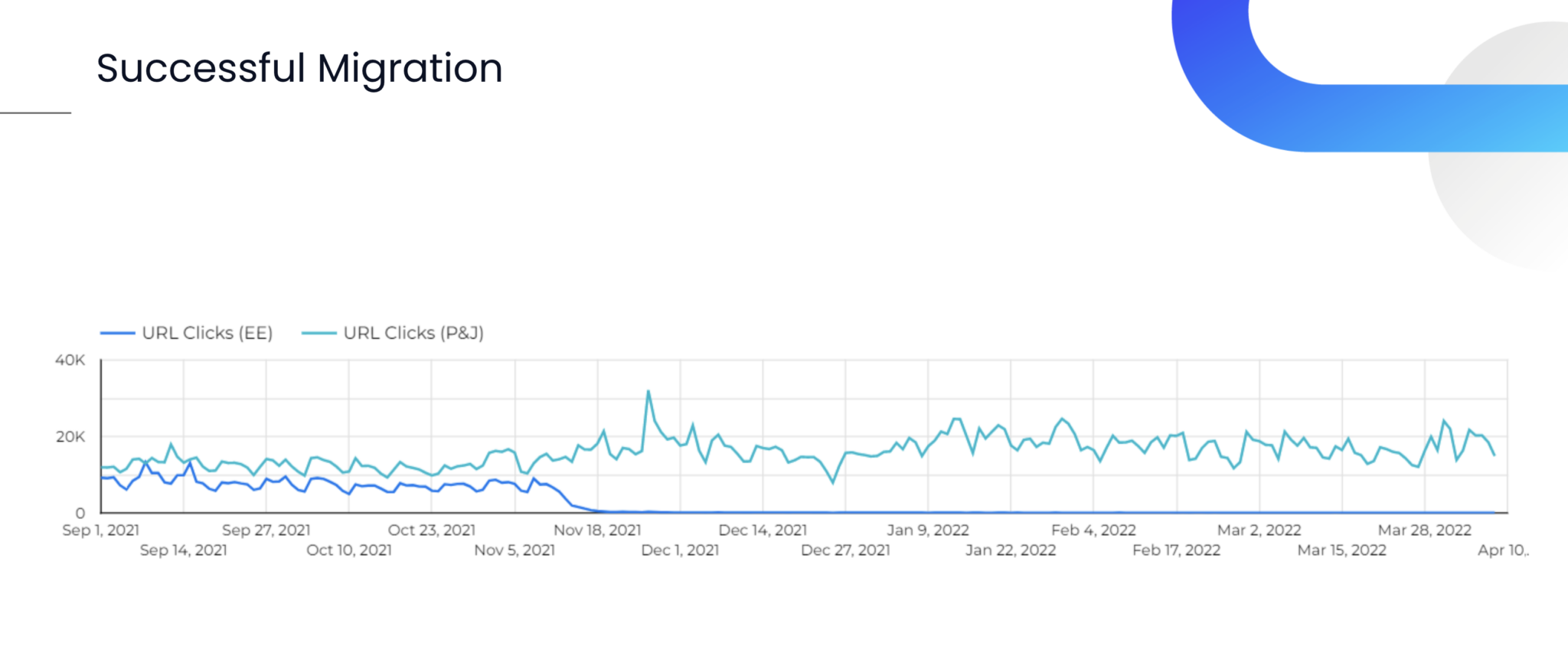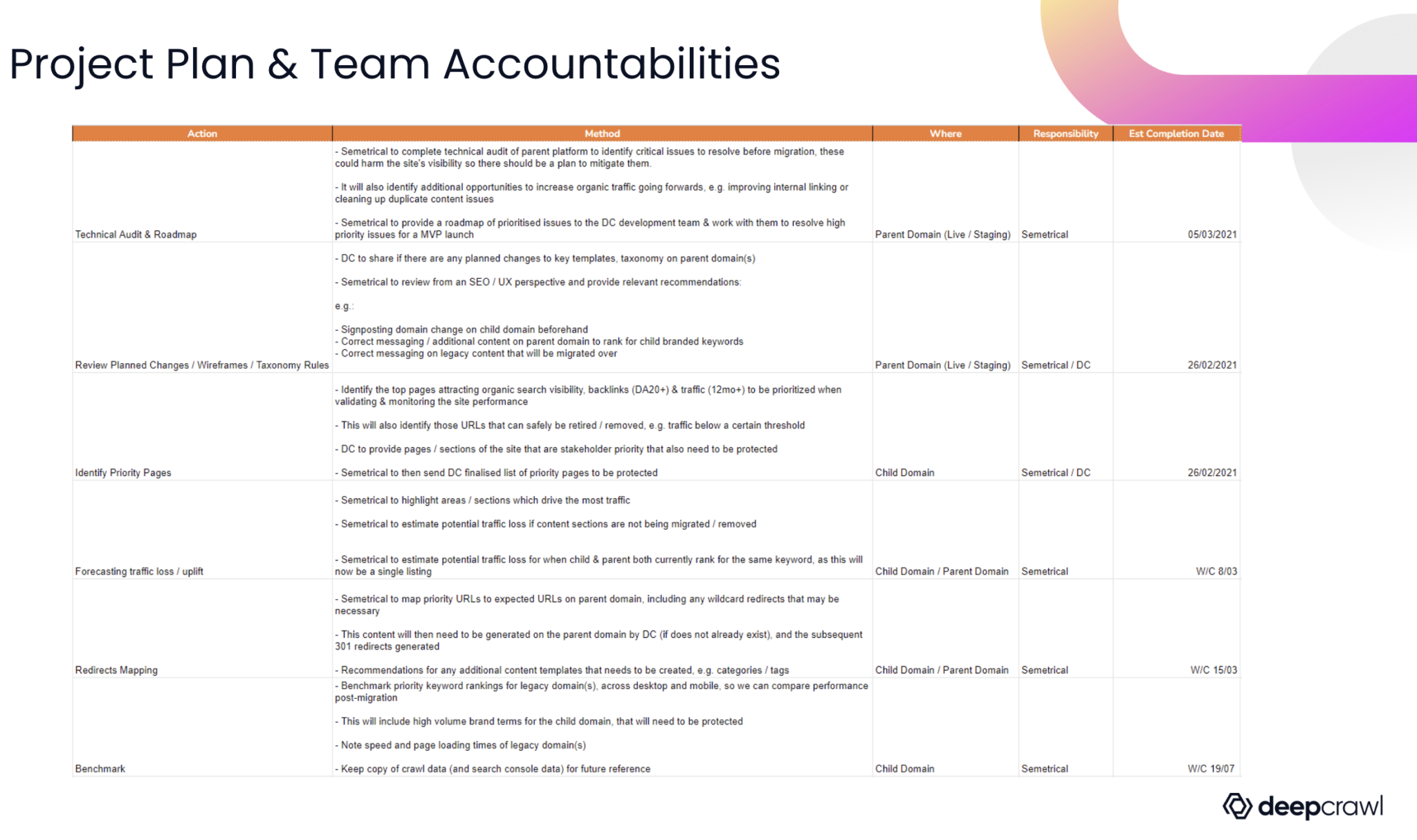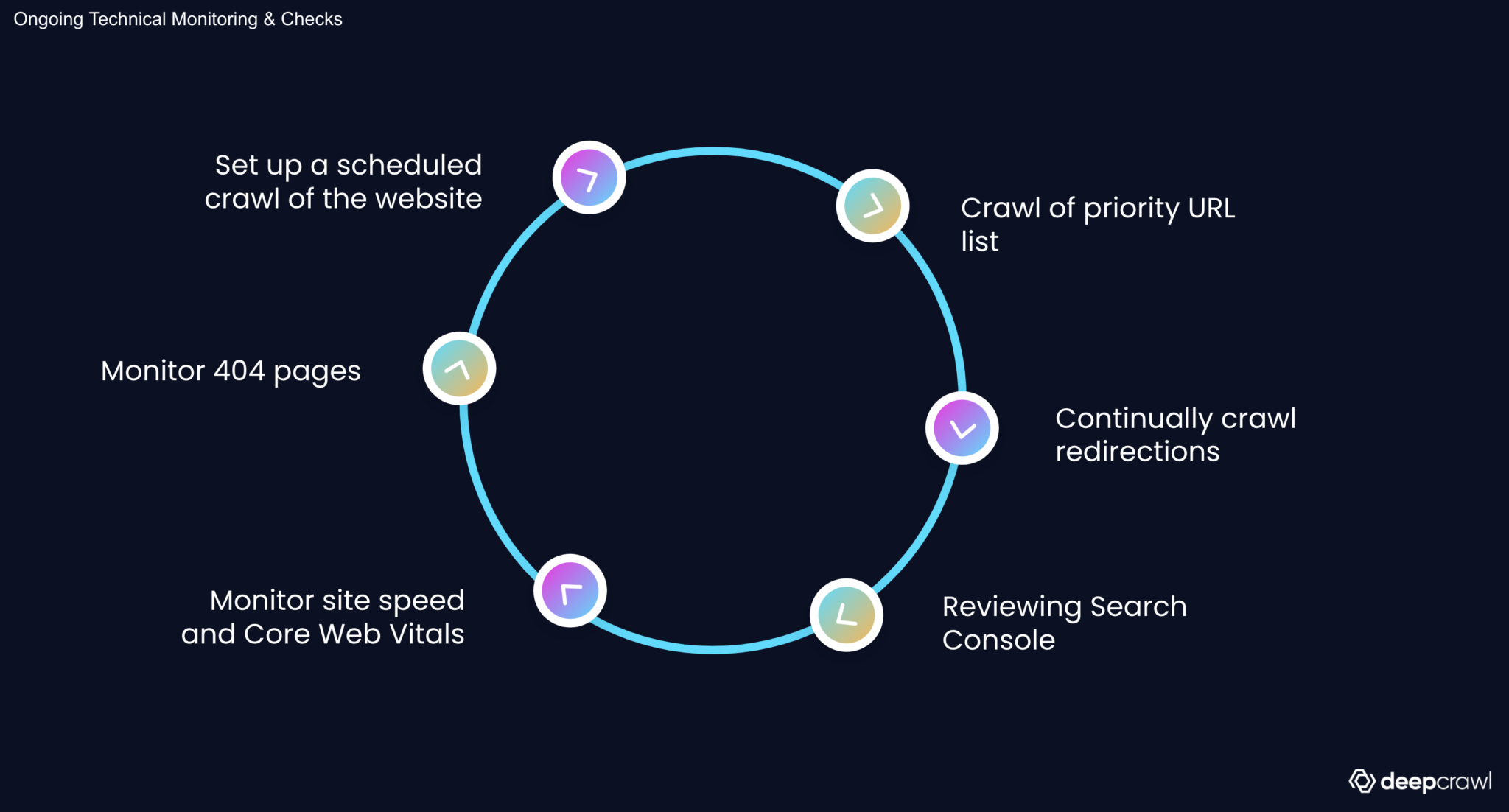The latest in Deepcrawl’s ongoing webinar series is a deep dive into how to succeed with website migrations—while minimizing the risk of traffic loss and search ranking loss.
One of Deepcrawl’s Senior Technical SEOs, Anne Berlin, was joined by Benjamin Beckwith, Director of Organic Marketing at the award-winning digital agency, Semetrical. Beckwith draws on his extensive experience with site migrations of all sizes to illustrate common pitfalls encountered during migrations and the best practices that can help website teams avoid these common migration challenges. As we learn from the webinar, migrating your website can be tricky but with sufficient planning, ongoing monitoring, and input from core site stakeholders, it is possible to migrate successfully and with minimal chance of things going wrong.
Watch the full webinar (including Q&A!) above, or read on for key takeaways.
What are site migrations?
Site migrations can encompass a broad range of changes relating to a website’s setup.
“It can range from URL changes to completely moving a website to a new location,’” Beckwith says. He lists the following as common types of site migrations:
- Domain name changes
- HTTP protocol changes
- URL clean-ups
- TLD changes
- Merging content
- Structural changes
- Website redesigns
- Merging websites
- Platform changes
- Subdomain and subfolder
Unsurprisingly, site migrations can be complex projects to undertake — particularly for large, enterprise-scale websites that house hundreds of thousands of pages (or more). Getting the site migration process right is crucial if you want to avoid losses in website traffic due to changes in your search engine results.
As Beckwith highlights, failing migrations are not a pretty sight:
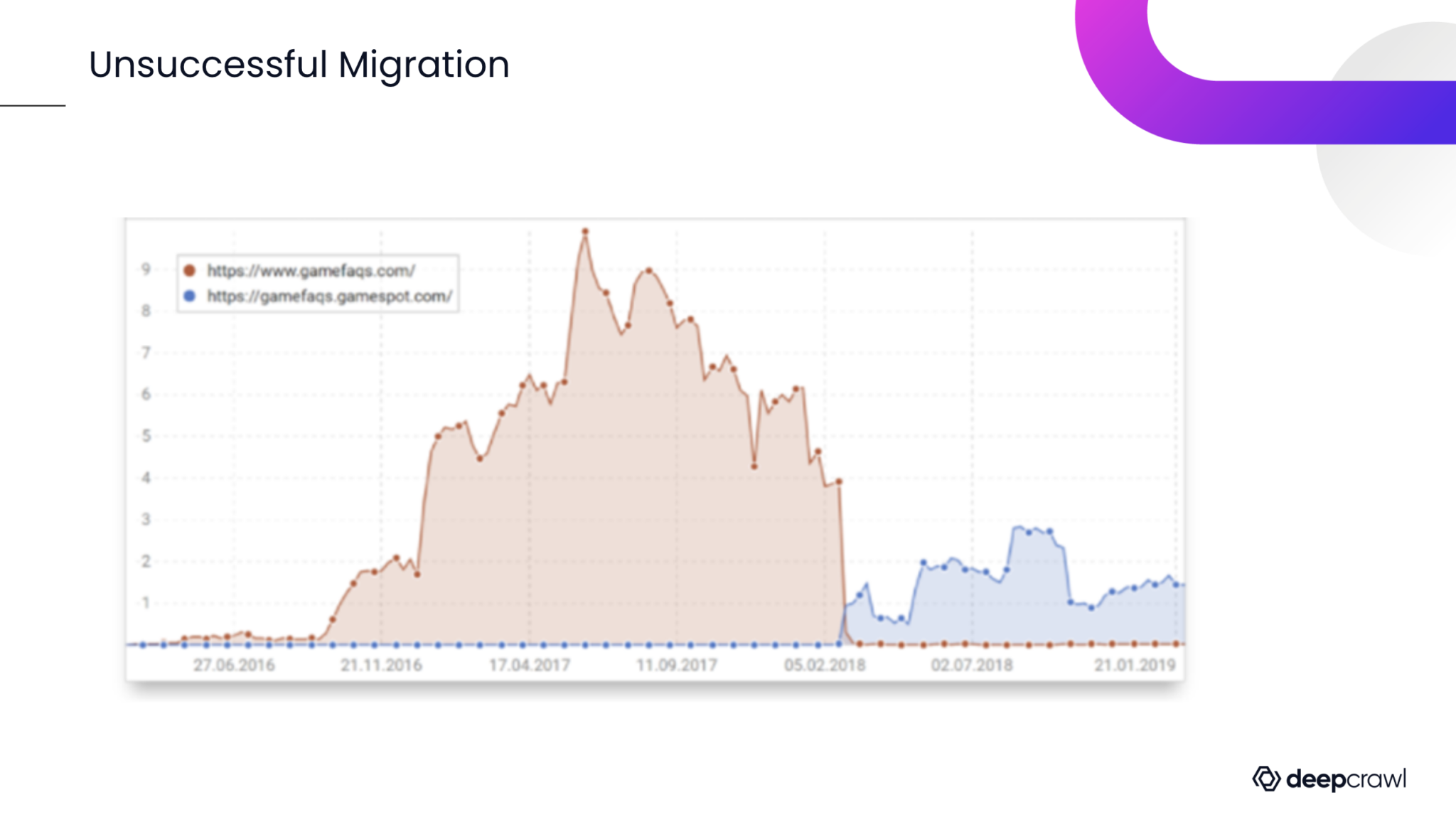
On the other hand, successfully executed site migrations can restabilize and start improving your online presence relatively quickly:
“Always involve the SEO team from the beginning.”
Beckwith sees SEO experts as being massively important to the success of site migrations. SEOs should have a deep understanding of the inherent risks to traffic and rankings that come alongside migration projects. Good SEOs are likely to pick up on a vast array of migration issues that others commonly miss, including:
- Legacy redirects that have not been moved
- Googlebot being blocked
- Priority URLs not migrating
- Failures to update internal links
- Unplanned URL changes
- Legacy URLs being included on XML sitemaps
- Canonicals referencing staging URLs
- Culling URLs with backlinks
- JavaScript rendering issues on the new site
Forecast Scenarios to Boost Buy-In for Site Migrations
It’s also important to involve other key internal stakeholders in your site migration plans to ensure you have the buy-in, support, and resources required to successfully execute the migration. Some within the business will likely need convincing that a site migration is the best course of action. Beckwith suggests boosting internal buy-in with forecasting models that show different scenario outcomes, as well as using data to better educate stakeholders about the risks and opportunities involved—and to make a case for the resources you’ll need.
Beckwith also acknowledges that in some cases, the practicalities of a site migration will require you to mitigate the risks with whatever resources you have available—so project planning ahead of a site migration can be a key factor in success.
Best Practices for Website Migrations
Beckwith splits out site migration best practices into five key stages:
1. Planning and scoping a site migration project
He suggests the following questions as a good starting point:
- Why do stakeholders want to migrate?
- What is the business hoping to achieve and what does success look like?
- What migration is taking place?
Beckwith also advises that website migrations should be scheduled to happen during a seasonal low in website traffic, and with a clear document of team accountabilities and timelines to know who needs to be doing what and when.
He provides this example project plan and team accountability document for site migrations:
He also highlights the importance of ensuring you have access to all the required data at the outset of your migration project. This data might include:
2. Pre-migration preparation
“Review [planned] changes as early on in the process as possible,” Beckwith advises, “as they could impact the success or affect your pre-migration plans.”
After this, it is also important to identify your priority URLs. This can be done by crawling your existing website, looking at data from your analytics platforms, examining your backlink data, website traffic data, and social share data, and discussing with stakeholders what their own priority links are.
The next phase of pre-migration prep, according to Beckwith, is mapping URLs — that is, identifying where URLs will be moving to and the potential new redirects that may be required.
As an example, a map of URLs for a site migration project might look something like this:
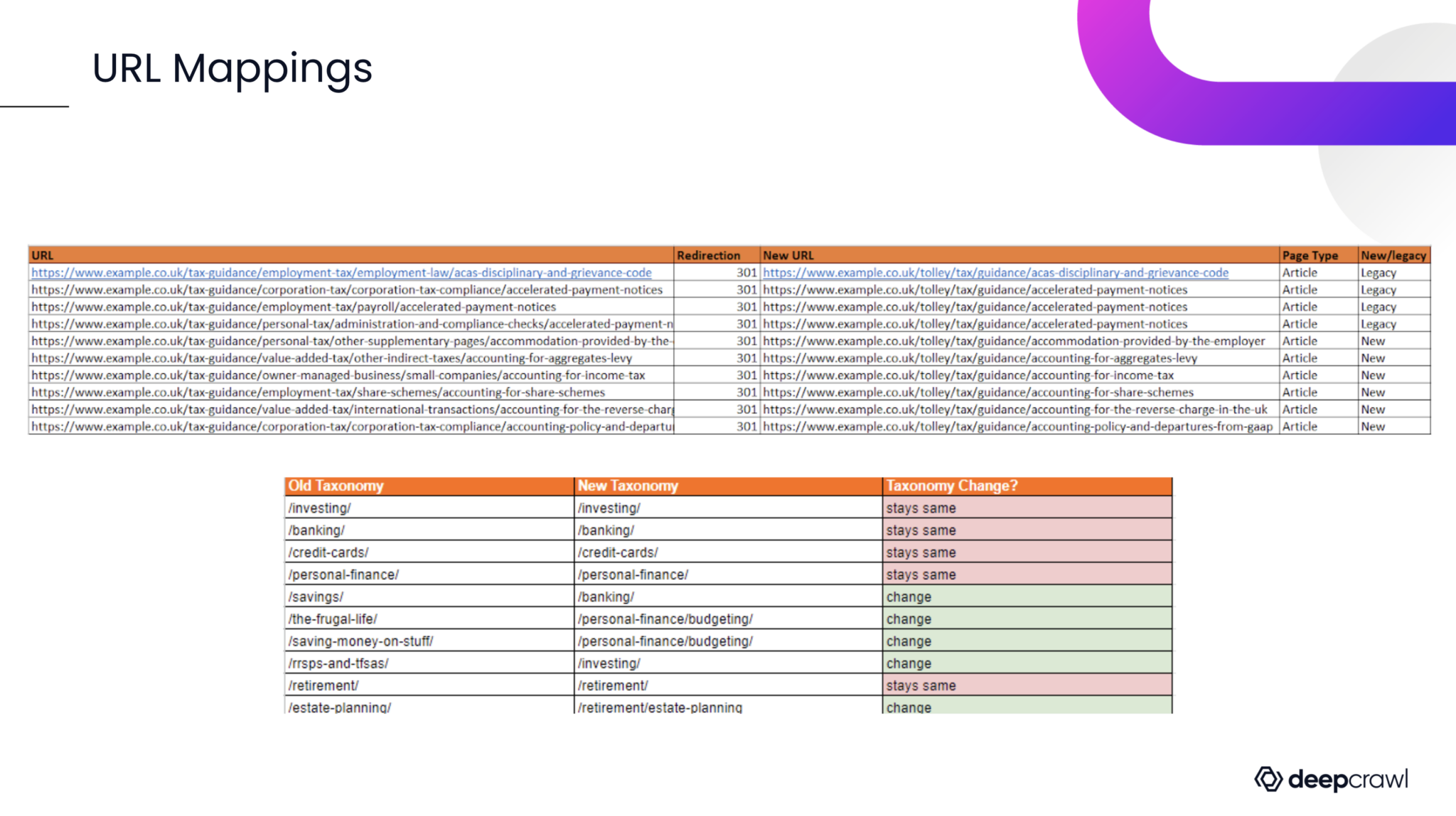
You’ll also need to get your benchmarking metrics in place ahead of time, says Beckwith. You may want to benchmark pre- and post-migration metrics such as:
- Priority keyword rankings across desktop and mobile
- Site speed and page loading times for key templates
- Snapshot of branded SERPs
- URL-level metrics for priority pages (average conversion rates and average organic traffic)
[Note: Here is a useful Site Migration Benchmarking Template for you to use in your own site migration projects.]
3. Pre-migration testing
Beckwith suggests making sure your staging site is blocked from all search engines. “My preference would be an authentication layer,” he says.
The next step is to audit the staging website before testing the redirections and updating the robots.txt rules.
Beckwith suggests the following checklist when auditing your migration staging site:
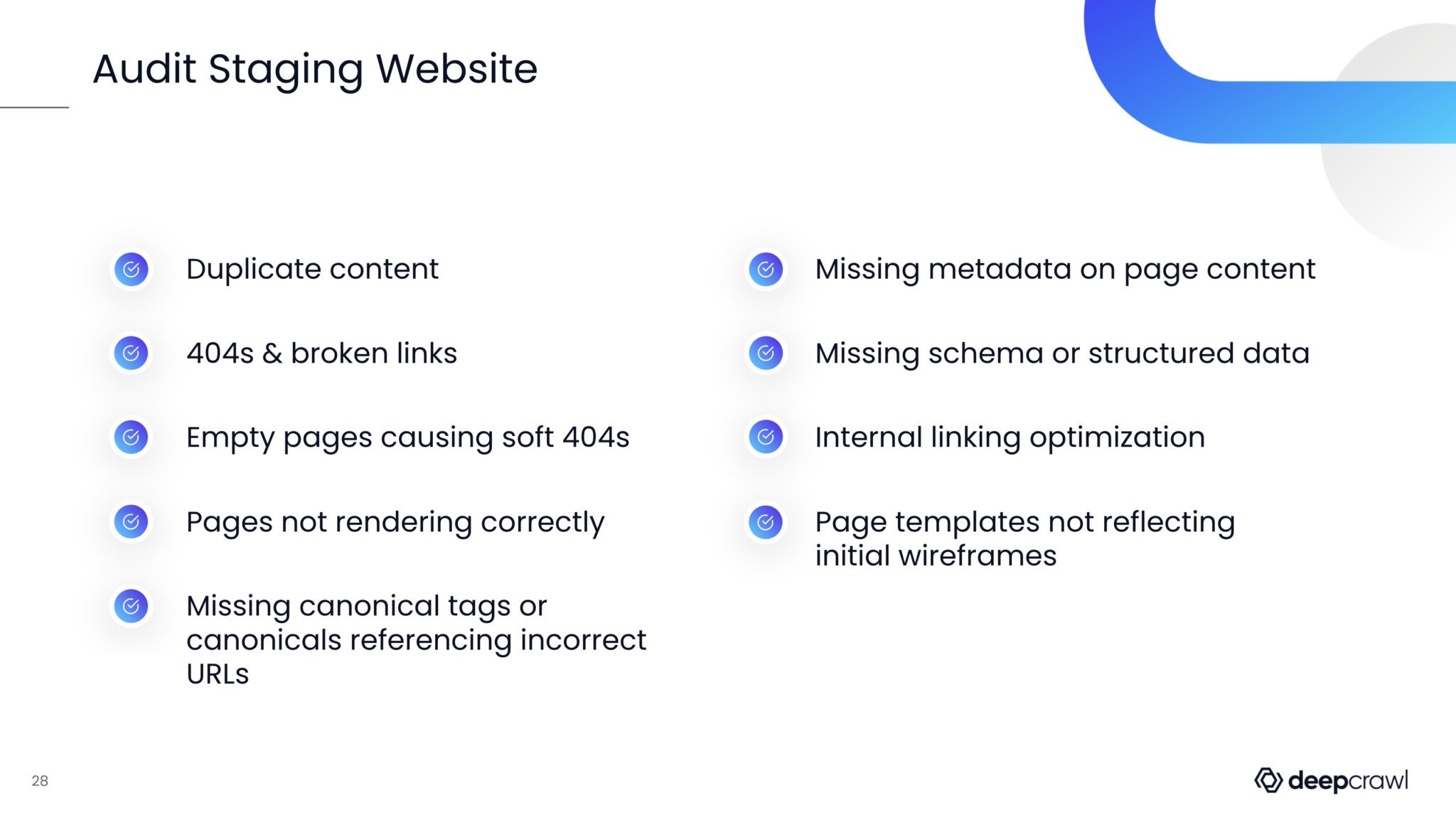
4. On-the-day support
On the day your site migration goes live, you should also test to ensure everything has gone as expected. Redirection rules can be working fine in your staging environment, but it’s worth checking nothing has broken or ended up pointing to the wrong URL in the now-live site. “Never assume redirects are going to work,” warned Beckwith.
Following testing your live redirects, he suggests crawling your priority URL list to check for technical issues, followed by running a full site crawl. It is also crucial to check tracking codes across external ad platforms and campaign URL updates in order to prevent loss of traffic.
5. Post-migration
After your migration, there are a number of ongoing monitoring and checks that website teams should ensure are in place. Beckwith also suggests that rankings and traffic should be regularly monitored for at least three months.
Site Migration Pitfalls
Beckwith points to a number of pitfalls he has seen across his years of experience with website migrations. He suggests looking out for the following mistakes that can easily happen when working on a site migration project:
- Not testing redirections until post-launch — Be sure to test redirects in the staging environment.
- Rushing migration projects — Things can easily get missed when trying to complete things too quickly.
- Only scoping changes partway through the migration project — Sometimes this can’t be helped, so be prepared!
- Robots.txt not being updated.
- Not doing rigorous testing on staging.
- Not testing JavaScript rendering (if applicable to your site).
- Not agreeing on clear objectives from the outset.
- Not backing up the existing website.
- Launching during a seasonal high.
Additional Tips for Site Migrations
Beckwith also provides some useful tips to make your migration that little bit easier:
- Track priority keywords prior to the migration taking place.
- Annotate when the migration went live in your analytics platform.
- Decide which URLs do not need to be migrated.
- If changing domains, use the change of address functionality in Google Search Console.
- Run paid ads if you are changing your domain name or consolidating sites – it’s important to provide a good customer experience and make sure your users are aware of the change.
- Move and update disavow files if the domain is changing.
11 key website migration takeaways
- Get an SEO on board from the beginning.
- Use data and educate stakeholders for buy-in.
- Create allies for the project across your organization.
- Key objectives need to be agreed upon before the project gets going.
- A project plan with accountabilities and a site migration checklist will aid in creating a smooth migration.
- Test and audit the website both pre- and post-migration.
- Identify your priority URLs.
- Make sure benchmark data is collected before you migrate.
- Test mapping and URL redirects prior to migrating.
- Review tracking and campaign codes.
- Monitor performance post-migration.
For more on site migrations, check out Deepcrawl’s SEO Office Hours Recaps on domain migrations, or download Benjamin Beckwith’s Website Migration Checklist for SEO.


